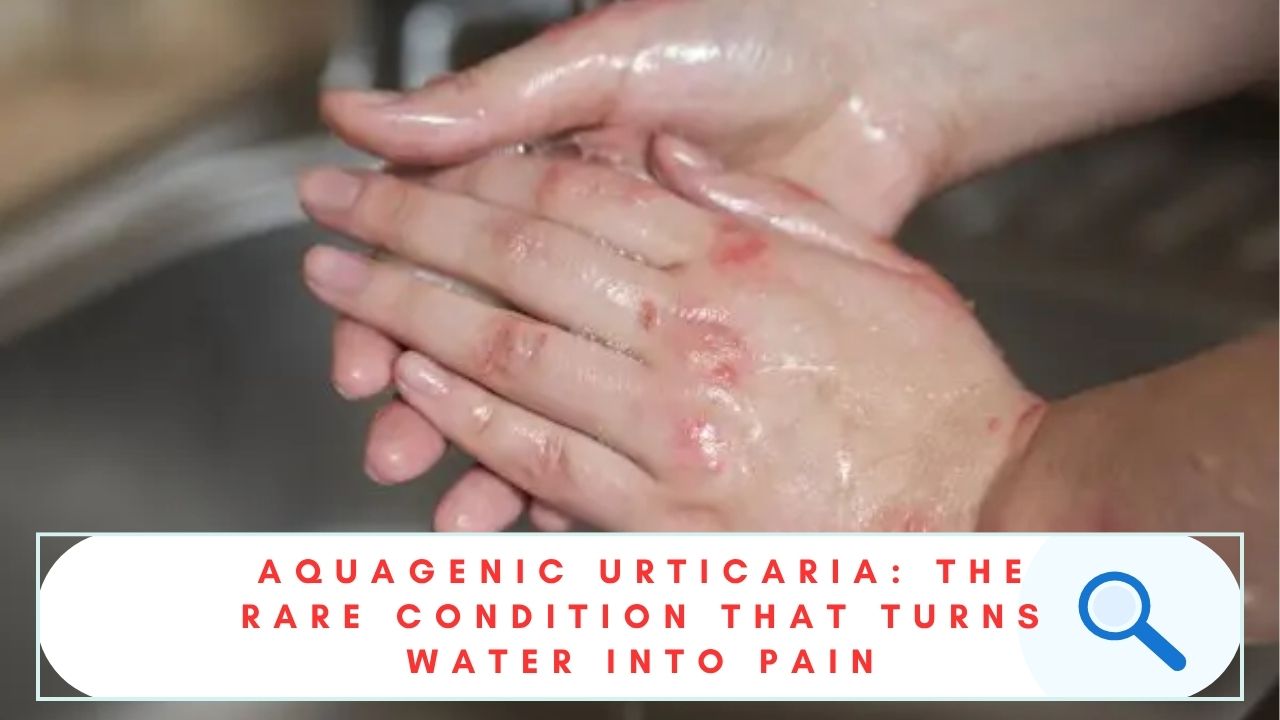Aquagenic Urticaria: The Rare Condition That Turns Water Into Pain
For most people, water is a source if life, healing, and calm. We drink it to quench our thirst, we bathe in it to feel and refreshed, and we turn to it for peace when the world becomes overwhelming. But for a very small number of people, water is not healing – it’s a trigger for pain. This rare and often misunderstood condition is know as Aquagenic Urticaria.

What is Aquagenic Urticaria?
Aquagenic Urticaria, sometimes referred to as a “water energy,” is a condition where skin reacts to contact with water by breaking out in painful hives or rashes. Even clean, room-temperature water can result in itching, redness, and burning sensations. The cause is not fully understood, but some experts believe the water interacts with a component in or on the skin, triggering a histamine release and causing the reaction.
For those who suffer from Aquagenic Urticaria, everyday tasks like taking a shower, walking in the rain, or even crying can lead to extreme discomfort. Imagine a life where a warm bath is not a luxury but a punishment.
How Rare is Aquagenic Urticaria?
With fewer than 100 documented cases globally, Aquagenic Urticaria is considered one of the rarest skin conditions in the world. because of its rarity, many people go undiagnosed for years, often dismissed or misdiagnosed with more common skin irritations.
Aquagenic Urticaria and Emotional Toll
Many patients struggle with feelings of isolation. How do you explain to someone that you’re allergic to water – something that sustains all life? The emotional burden can be just as painful as the physical symptoms.
Documented Cases and Statistics
Aquagenic Urticaria has been studied in only a handful of medical reports. One such case report and literature review published on NCBI highlights how rare and complex the condition is. Only a small number of individuals around the world have been diagnosed, making research and awareness a challenge.
Why Is It So Rare?
Its extreme rarity and often mild or misdiagnosed symptoms contribute to the lack of data.
Aquagenic Urticaria Symptoms
The symptoms often appear within minutes after skin contact with water:
- Red, raised hives or rash
- Burning or stinging sensation
- Itching and welts, especially on the torso, neck, and face
Common Skin Reactions
Many sufferers describe the sensation as stinging or biting. The rash usually disappears within 30-60 minutes after water exposure.
Aquagenic Urticaria Face Rash and Showers
The face is frequently affected because of its exposure during daily hygiene routines. Learn more about healthy water habits here.
Mild Aquagenic Urticaria: A Hidden Struggle
Not all cases are extreme. Some people experience only mild symptoms – small, itchy bumps or a tingling sensation. These symptoms can easily be overlooked or mistaken for heat rash or dry skin.
Signs of a Milder Form
A few red patches, light stinging, or short-term irritation that fades quickly.
Managing Mild Cases
Use of antihistamines, shorter water exposure, and protective creams can make a big difference.
Heat Rash After Shower vs. Aquagenic Urticaria
How to Tell Them Apart
Heat rash usually occurs in hot, humid conditions. Aquagenic Urticaria strikes regardless of water temperature or climate.
How to Shower with Aquagenic Urticaria
- Keep showers short and cool
- Pat the skin dry gently
- Use barrier creams beforehand
Aquagenic Pruritus vs Aquagenic Urticaria
Itching Without Rash? It Might Be Prutitus
Aquagenic pruritus causes itching after water contact, but without visible hives.
When Both Itching and Rash Occur
If welts or bumps accompany the itching, it’s more likely Aquagenic Urticaria.
Causes of Aquagenic Urticaria
Immune System Misfire
Researchers believe water might interact with a compound in the skin, causing immune cells to release histamine.
Genetic or Acquired?
Some cases begin in adolescence, others after illness or hormonal changes.
Aquatic Urticaria Treatment Options
Medications
- Non-sedating antihistamines (cetirizine, loratadine)
- Leukotriene inhibitors
- Omalizumab in sever cases
Lifestyle & Skin Care Adjustments
- Use of barrier creams (e.g., petroleum jelly)
- Avoid long showers
- Wear gloves when cleaning
Living with Aquatic Urticaria
For many, life with AU is a constant balance of managing symptoms and emotions. Social situations, exercise, and even intimacy become complicated. The fear of triggering an outbreak adds a psychological layer that often leads to anxiety or depression.
Life Expectancy and Mental Health
Aquagenic Urticaria doesn’t shorten life expectancy, but it’s impact on quality of life is profound. Mental health support is essential. Discover how stress and sleep are linked.
Aquagenic Urticaria in the Digital Age
Support Groups and Forums
Online platforms like Reddit and Facebook host communities where sufferers share their stories, treatments, and encouragement.
Raising Awareness Through Social Media
Hashtags like #AquagenicUrticaria or #WaterAllergy help increase visibility and connect people around the world.
Aquagenic Urticaria FAQs
Can you be allergic to drinking water?
No. AU involves skin contact, not ingestion. Drinking water is safe.
Can Aquagenic Urticaria lead to death?
No deaths are directly linked to AU, though its emotional effects can be severe.
Is it really an allergy?
Not in the traditional sense. It’s an allergy-like reaction caused by immune IgE response.
How do you stay hydrated if you’re afraid of water?
Though drinking water is safe, fear can still arise. Here are the best times to drink water and how it helps with weight loss.
Aquagenic Urticaria is a painful reminder that even the most life-giving elements can turn against us. But with better awareness, empathy, and research, there is hope for better treatments and understanding. For now, those living with AU continue to battle an invisible enemy with quiet strength – and water-resistant courage.






One Comment
Pingback: